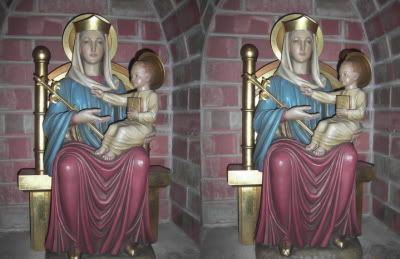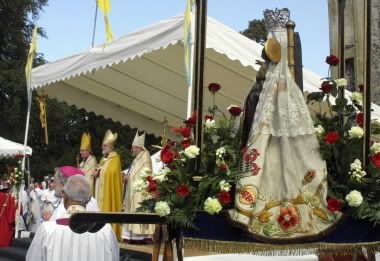
Today is the feast of Our Lady of Walsingham. Above is the Walsingham image at my parish--one of the best, in my opinion--fashioned in the 1950s by a German woodcarver. Below is a three-dimensional view of the same statue. Just cross your eyes until the two pictures become one.

Our Lady of Walsingham refers to the eleventh century English Marian apparition of the Blessed Virgin Mary to the Saxon noblewoman, Richeldis de Faverches. Her husband, the Lord of the Manor of Walsingham Parva, died leaving her a young widow with a son named Geoffrey.
At this time there was a great deal of interest in the Holy Land and people undertook long and often dangerous pilgrimages there. Christian armies were soon to be engaged in a number of Crusades to liberate the holy sites from Muslim control and it is believed that Geoffrey eventually joined one of those Crusades as an expression of his Christian faith.
For Richeldis, however, the life of prayer and good works was rewarded by a vision in the year 1061. In this vision she was taken by Mary to be shown the house in Nazareth where Gabriel had announced the news of the birth of Jesus. Mary asked Richeldis to build an exact replica of that house in Walsingham. This is how Walsingham became known as England's Nazareth.
The vision was repeated three times, according to legend, and retold through a fifteenth century ballad. The materials given by Richeldis were finally constructed miraculously one night into the Holy House, while she kept a vigil of prayer.
In passing on his guardianship of the Holy House, Geoffrey de Faverches left instructions for the building of a Priory in Walsingham. The Priory passed into the care of Augustinian Canons sometime between 1146 and 1174. It was this Priory, housing the simple wooden structure Richeldis had been asked to build, which became the focus of pilgrimage to Walsingham. Royal patronage helped the Shrine to grow in wealth and popularity, receiving visits from Henry III, Edward II, Edward III, Henry IV, Edward IV, Henry VII and Henry VIII, who finally brought about its destruction in 1538.
After nearly four hundred years, the 20th century saw the restoration of pilgrimage to Walsingham as a regular feature of Christian life in these islands, and indeed beyond.
The English shrine is here. The American proto-shrine is here.

The Archbishop of Canterbury, Dr. Rowan Williams, gave the sermon at the National Pilgrimage to Walsingham in 2004. In his message, he noted:
For centuries, Christians have kept coming back to the idea that what happens in Mary is what has to happen to some degree in each of us. She, uniquely and once for all, says a yes so complete that her entire material life is changed by the coming of God to her; God's everlasting gift of himself that is the Son, the Word, emerges from her to begin that life which will change everything in creation. But we are called to the same job, to give God room so that we may be changed, so that the eternal Word will live in us and speak and act in love to others. Only so are we 'magnified', given our full dignity and splendour--not by rushing around in panic defending ourselves and standing on our dignity, but by being still enough to reflect and absorb the light flowing from God the Holy Trinity, something so wonderful that it can put into perspective the fears and pettinesses that we think are real life, and silence us for a moment, letting true life in.
The entire text of the sermon can be found here.


No comments:
Post a Comment